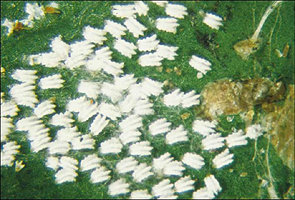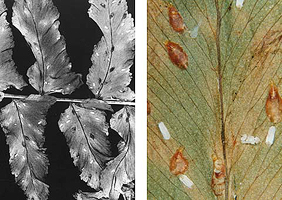|
|
Back to Pest Identification and Diagnosis
| Introduction to Scales | Boisduval Scale | Fern Scale | ||
| Hemispherical Scale | Brown Soft Scale | Tessellated Scale |
 |
 |
|
| White Males From: University of Florida |
White Males and Brown Females From: Skjoldlus (Coccinea, Hom.) i Norge |
| DESCRIPTION | |
|
Adults: Female fern scale armor is oystershell or pear shaped, flat, light brown with the crawler cast skin a paler brown. Sometimes the second stage armor is also paler than the adult armor. They are 1.5 to 2.5 millimeters long. The male armor is white felted, three-ridged, and the crawler cast skin is beige to yellowish brown. Adult males are tiny, two-winged, gnat-like insects that are easily overlooked.
Eggs: Eggs of armored scales are usually oval and about 0.2 millimeter long. They are laid in groups under the female armor. Crawlers: Fern scale crawlers are about 0.2 millimeter long, flat, and yellow with red eyes. The legs and antennae are well developed. Nymphs: Female second-stage nymphs secrete an oval, pale brown armor about 0.8 millimeter long. Male second stage nymphs secrete a white armor which has three long ridges. Mature male second stage nymphs are about 1 millimeter long. |
|
| BIOLOGY | |
|
Host Plants: Fern scales mainly infest true ferns (not asparagus ferns) and liriope. This pest has been recorded from numerous foliage plants, citrus, and other woody ornamental trees and shrubs in Florida.
Damage: Infested ferns are disfigured by the presence of male second stage armor which is conspicuous against the dark green foliage. Ferns in commercial production sometimes tolerate a tremendous scale population with little noticeable reduction in vigor or color. Feeding by female scales causes yellow spots on some fern varieties and on liriope. Males do not feed beyond the second stage of development. Life Cycle: Little specific information is known about the biology of fern scales. Female scales lay their eggs under the armor. The female dies after the last egg is laid. Tiny crawlers hatch from the eggs and eventually emerge from under the mother's armor. The crawlers move about until they begin to feed by inserting their long, thread-like mouthparts into the leaf and sucking out nutrients. The insect molts into a second stage which begins to secrete a waxy material from under the rear of the first stage (crawler) cast skin. Eventually these insects molt into the adult stage. Female scales begin to secrete the adult armor at the rear of the second stage armor. Males emerge from their second stage armor as tiny, gnat-like insects that crawl or fly to female scales to mate. The armor remains fastened to the plant long after the scale insect leaves (male) or dies inside (female). When populations become dense, females tend to lay male eggs so that heavily infested plants become conspicuously spotted by second stage male armor. |
|
| MANAGEMENT STRATEGIES | |
|
Try to purchase plants from a supplier who does not have a fern scale infestation.
Pesticides: When fern scales are encountered, horticultural oils give adequate control without excessive phytotoxicity to ferns. Two thorough treatments 2 weeks apart should give good control. Ferns are notoriously sensitive to pesticides. Whenever treating ferns and other sensitive plants, treat at a time that the pesticide will be dry on the foliage before the plants are exposed to full sunlight. For specific chemical control recommendations, consult the Cooperative Extension Service. |
| Introduction to Scales | Boisduval Scale | Fern Scale | ||
| Hemispherical Scale | Brown Soft Scale | Tessellated Scale |
Back to Pest Identification and Diagnosis
 |
(C) Regents of the University of
Minnesota. All rights reserved. |
 |
 |